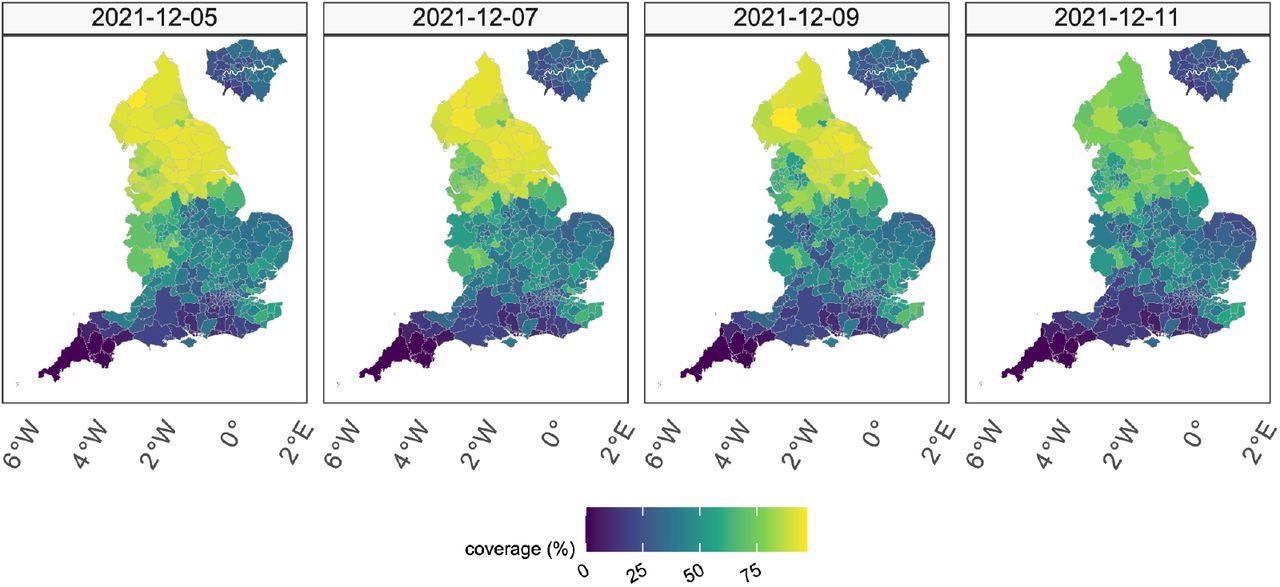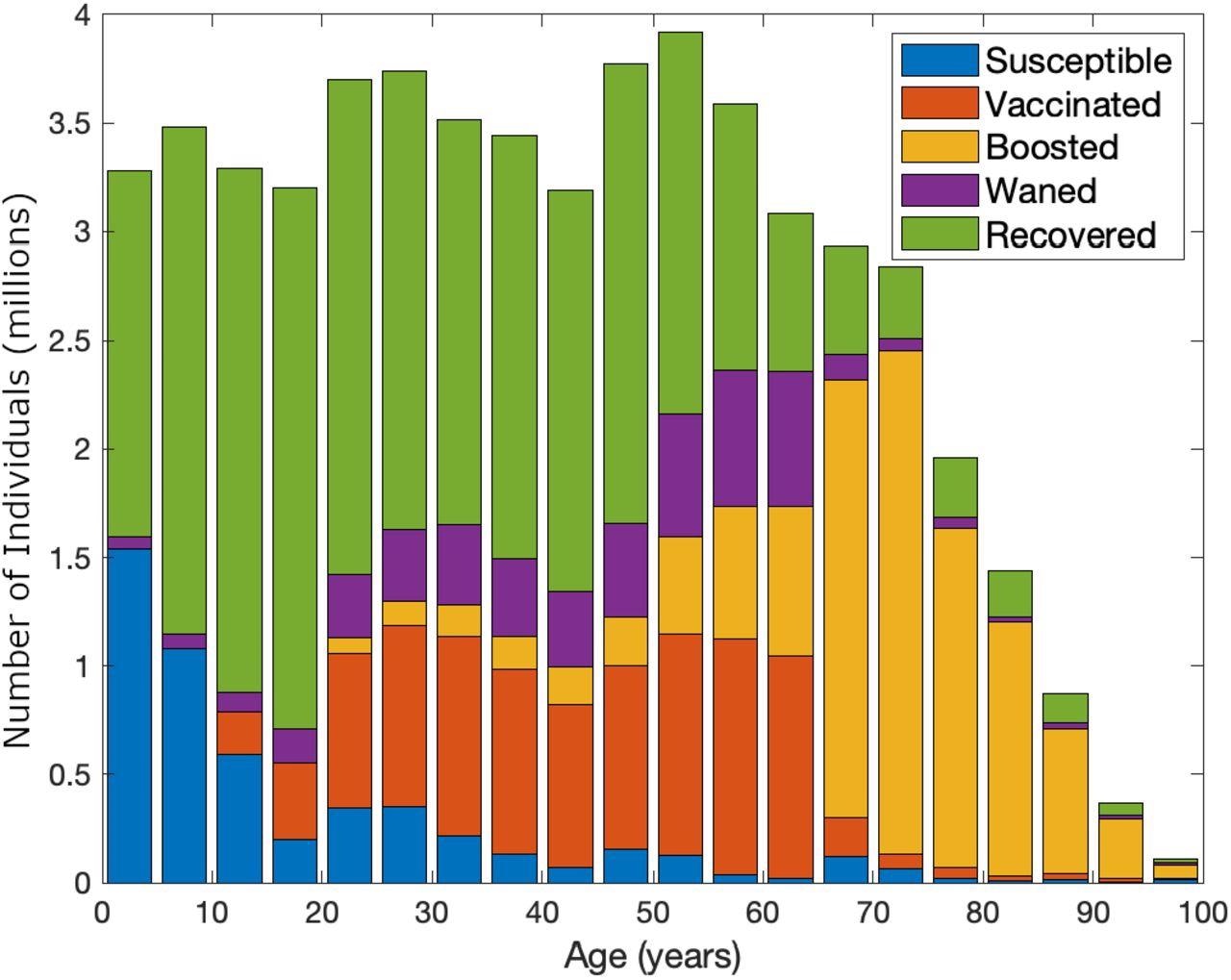
 *Important notice: medRxiv publishes preliminary scientific reports that are not peer-reviewed and, therefore, should not be regarded as conclusive, guide clinical practice/health-related behavior, or treated as established information.
*Important notice: medRxiv publishes preliminary scientific reports that are not peer-reviewed and, therefore, should not be regarded as conclusive, guide clinical practice/health-related behavior, or treated as established information.
The SARS-CoV-2 Omicron variant
Since the beginning of the coronavirus disease 2019 (COVID-19) pandemic, several different SARS-CoV-2 variants with enhanced immunological fitness have emerged worldwide. On November 24, 2021, the SARS-CoV-2 Omicron (B.1.1.529) variant was first reported in South Africa. Soon after, the World Health Organization (WHO) designated Omicron as a variant of concern (VOC).

Coverage of testing in England able to identify S-Gene Target Failure (SGFT). Regions of the South West which have lower coverage, are less likely to be able to rapidly discriminate between Omicron and Delta variants.
Currently, there is a massive surge of COVID-19 cases globally after the emergence of Omicron. This is likely due to the increased transmissibility of this variant compared to other SARS-CoV-2 strains due to the over 30 mutations in its spike (S) protein region. In addition to increasing its transmissibility, these mutations also help the Omicron variant evade immunity acquired from existing vaccines and previous SARS-CoV-2 infections.
About the study
In the present study, the researchers conducted a sensitivity analysis and mathematical modeling using SARS-CoV-2 data from the U.K. to predict the Omicron variant transmissibility, hospital admissions, mortality rate, and effect of non-pharmaceutical interventions in the future.
The early signs of Omicron transmission were analyzed from the U.K. Health Security Agency (UKHSA) line list case data. Subsequently, the UKHSA line list case and reinfection data, as well as a previously developed mathematical model by the researchers, were used to simulate SARS-CoV-2 transmission dynamics within seven National Health Service (NHS) regions of England. The authors included Omicron in their previous model with the SARS-CoV-2 wildtype, Alpha, and Delta variants.
While the BA.1 and BA.3 Omicron sublineages fail to amplify in the S-gene target (SGTF), the BA.2 sublineages did not display SGTF. The SARS-CoV-2 polymerase chain reaction (PCR) test in the U.K. Lighthouse laboratories employing the TaqPath S-gene target was used to track Omicron progression.
The participants in the model were divided into 21 age groups, with five-year age differences. COVID-19 cases in the model were classified as the first infection in a household (F), subsequent infection from symptomatic and asymptomatic household members (SI, SA), and the first and subsequently detected cases in a quarantined household (QF, QS). The degree of vaccine protection against Omicron was determined in Pfizer, Moderna, or AstraZeneca vaccine recipients.
Study findings
The results indicated that during early December 2021, SGTF identified was highest in Northeast England and lowest in Southwest England, while lab coverage was not consistent in London.
From November 1, 2021, to December 13, 2021, Delta variant S-gene positive cases showed a slow decline, whereas the Omicron SGTF cases showed a rapid increase. However, from the start of December 2021, there was a slight decline in the growth rate of SGTF cases due to delays in reporting and variations in the age distribution of the SARS-CoV-2 cases.
During the emergence of Omicron in early December 2021, there was a surge in the reinfection rate across all age groups, especially 20-29-year-old adults. After stratifying by age group and region of England, a rapid increase in reinfection of young adults was observed in all regions, including those with low SGTF coverage. In contrast, the modeled infection showed an equal distribution of Omicron cases in individuals between 25 to 44 years of age.

Estimated daily % of cases that are reinfections for England, stratified by age group, showing substantial increases during December in many age groups above a previously relatively constant reinfection rate for each age group, indicative of the omicron invasion. Observations are shown as dots, fitted spline as lines and 95% confidence intervals as shaded regions.
The comparison between SGTF cases from UKHSA data and Omicron cases in the study’s transmission model indicated that the projected proportion of new infections was due to the Omicron variant.
According to the model estimated immune distribution against Omicron, young adults were most susceptible to infection, convalescent immunity was primarily observed in those below 60 years of age, and the vast majority of individuals 60 years or older were protected by booster vaccination.

Estimated distribution of immune status by age from the model at the start of December 2021. Susceptible individuals (who have no protection, blue) are concentrated in the youngest age-groups, while those whose immunity is from infection (recovered in green) are generally below 60. For those above 60 years old, the vast majority are protected by booster vaccines (yellow).
Conclusions
In the current study, the authors expanded their existing SARS-CoV-2 predictive model to include the dynamics of the Omicron variant from England and demonstrated a rapid relative growth of the Omicron variant compared to the Delta variant. In addition, there was an abrupt surge in infections, hospitalizations, and deaths following the increase in SGTF induced by Omicron. The study findings help predict future scenarios and the impact of various interventions associated with this new variant.
While TaqPath PCR testing has provided a clear picture of the relative growth of the Omicron variant, other measurements used in this study are significantly less certain and heavily influenced by reporting system latency and behavioral changes. Overall, the study’s projections indicate that Omicron can generate high levels of infections and hospitalizations that could disrupt health services.

 *Important notice: medRxiv publishes preliminary scientific reports that are not peer-reviewed and, therefore, should not be regarded as conclusive, guide clinical practice/health-related behavior, or treated as established information.
*Important notice: medRxiv publishes preliminary scientific reports that are not peer-reviewed and, therefore, should not be regarded as conclusive, guide clinical practice/health-related behavior, or treated as established information.